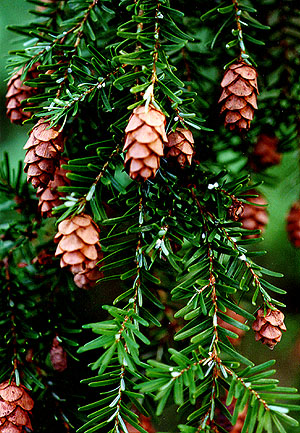 |
WESTERN HEMLOCK Pinaceae Western hemlock is a graceful tree with sweeping branches and delicate foliage. It grows to about 60 m tall and has a conspicuously drooping leader. The bark is rough, reddish-brown, thick and furrowed in older trees. The twigs are slender and roughened by the peg-like bases of fallen needles. The needles are short, flat, blunt, and clearly unequal in length (hence the specific epithet "hetero" = different, "phylla" = leaves), 5-20 mm long. The needles are yellowish-green above and show two white bands of stomata below. They are twisted at the base to appear two-ranked on the branches. The female cones are numerous, small (2 cm), oblong, light brown and papery when mature. Western hemlock grows in moderately dry to wet sites and is abundant in forests from low to middle elevations. Western hemlock is one of the most shade-tolerant trees on the Pacific coast and yet the highest growth rate ever measured in the temperate zone came from a 17-year-old western hemlock forest. Western hemlock also has the densest canopy of any tree species in the west, so that very few species can occupy the forest floor under it. However, it is limited to sites with an accumulation of organic matter in the soil, so it will not grow on recently deglaciated sites or raw floodplains. |